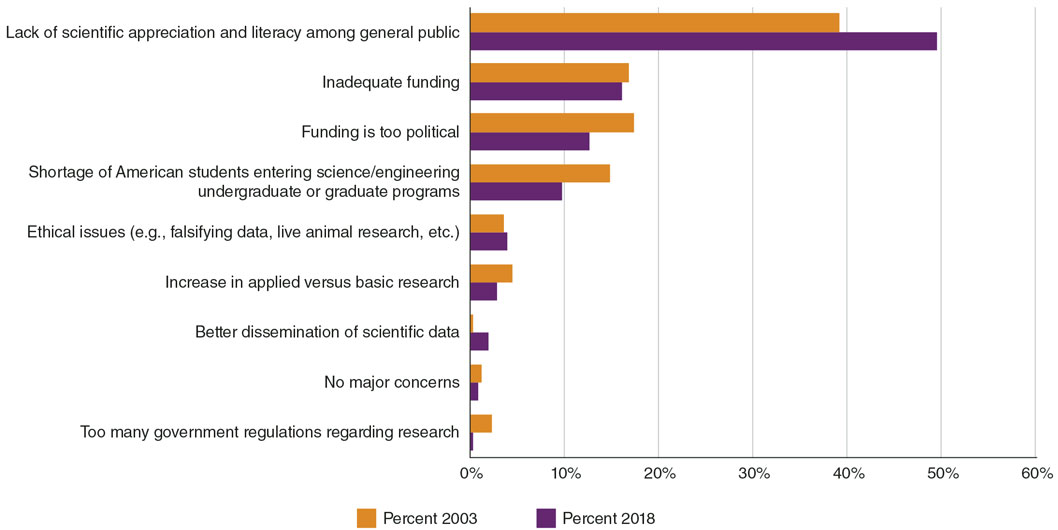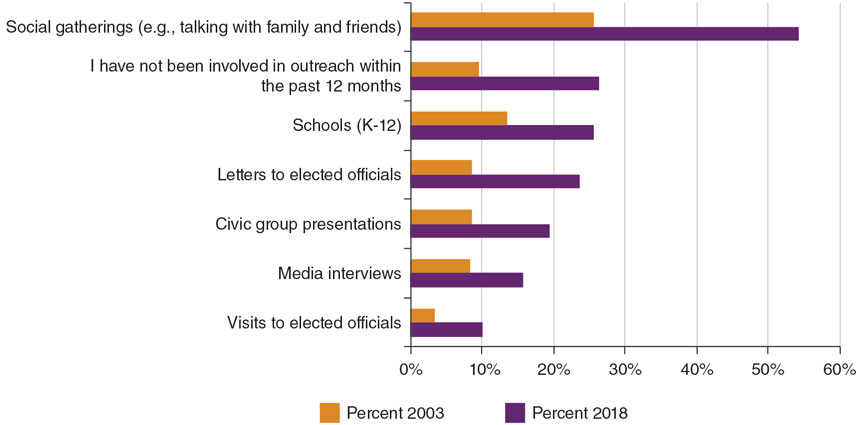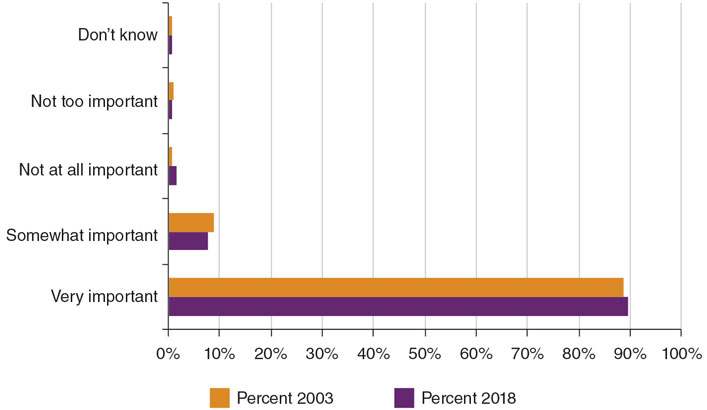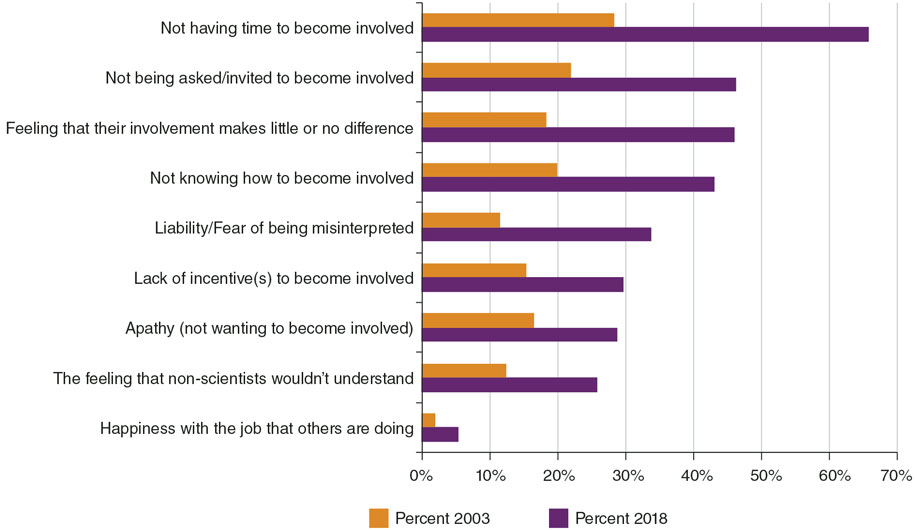Visibility May Be the Key to Increasing Support for Science

During a recent National Academy of Sciences (NAS) Colloquium on “Misinformation about Science in the Public Sphere,” a panelist quipped that scientists are trained to write in the “first person invisible” voice. His point was that science should be more about storytelling and unafraid of personalization; he urged scientists to be more involved in speaking out against the anti-science rhetoric that has been issuing from a variety of individuals and groups.
A recent survey conducted by Sigma Xi, The Scientific Research Honor Society and Research!America, a nonprofit alliance committed to raising the priority of research, investigated whether Sigma Xi members had changed their opinions about public outreach since a similar member survey was conducted in 2003. The results revealed increasing concern—from 39 percent of respondents in 2003 to 49 percent in 2018—about a “lack of scientific appreciation and literacy among the general public.” We interpret this heightened concern as a response to the upsurge in opposition to certain scientific conclusions—ranging from mildly frustrating and easily refutable claims that Earth is flat to dangerous rejection of childhood vaccination and denial of climate change.

Figure 1. Select one issue that you feel is the greatest current concern you have regarding scientific research?
Like many of the attendees of the NAS conference, we believe it is important for scientists to engage the public, as a way to boost public appreciation and support for science. Certainly there is agreement that something needs to change, because in both survey years, only a handful of scientists say they are happy with the job other people are doing to engage with the public. We were gratified to see several indications in the survey that scientists are ready to do more themselves, rather than rely on others. Many aren’t waiting and have stepped up. Indeed, more than 70 percent of respondents reported that they had been involved in some form of “outreach” during the past 12 months.

Figure 2. In which of the following outreach venues have you been involved during the past year? Select all that apply.
Scientists who engage with the public might choose to advance a variety of useful messages. The survey results indicate that a top concern among respondents is “inadequate funding” for scientific research, and in addition, nearly 90 percent of survey respondents in both years feel that it is “very important” that the United States maintains its role as a world leader in scientific research. Speaking out about these concerns makes sense for scientists and for all of us who are looking to science to find the solutions to a range of challenges involving our planet, our health, our security, and our safety. In short, scientists should speak to their role in serving the public’s interest.

Figure 3. How important do you think it is that the United States maintains its role as a world leader in scientific research?
To get the maximum effect from public engagement, we recommend that scientists consider the literature on science communication. Several speakers at the NAS conference underscored the effectiveness of scientists’ personal stories as vehicles for conveying complex information. For non-scientific audiences, interpreting statistics and figures can be arduous and boring. Evidence shows that stories that scientists can tell about their own research processes, or that of their colleagues, can provide a framework of real-world connections that can make science more accessible. Numerous storytelling platforms and venues have emerged in recent years—from live stages around the world with oral presentations, or in longer format on the written page—where volunteer scientists can be coached by expert teams to share their experiences in science, with great success. YouTube channels, podcasts, radio programs, and television productions now rely on storytelling to educate large audiences about complex issues in science. Although there are limited data at present to determine whether a storytelling approach is significantly increasing public appreciation, or whether that, in turn, leads to enhanced public support for science, many who study the science of science communication believe that storytelling is a useful approach.
Ultimately, sharing a personal story is about establishing trust with the audience. Although scientists take a highly rational and unemotional approach to their work, building trust with the public requires scientists to show a more vulnerable side. According to research conducted by Susan Fiske at Princeton University, trust is based on two main elements: warmth and competence. Fiske’s data show that scientists are viewed as highly competent, but only moderately warm. In today’s highly connected culture, scientists have an opportunity to use the internet to change this public perception by being more open about their values and objectives, as well as their research path, their points of excitement, the moments that made them think and change their minds, and the surprises they found in their data.

Figure 4. In your opinion, what are the major reasons why scientists might not become involved in outreach? Select all that apply.
Publicly sharing more personal aspects of one’s life can be daunting for anyone, and scientists are no different. But in our survey, the primary reason given for why scientists might not participate in outreach was not concerns about disclosure, but rather was “not having time to become involved.” Although we don’t know what respondents had in mind for the time it takes to become involved, we might be able to ease these concerns by citing new research that suggests that the very quick act of sharing a personal photo on social media can build trust with public audiences. Paige Jarreau recently described the results of her team’s work on this topic, writing in an American Scientist blog post that “we conclude that scientists who post “selfies” or self-portraits in their Instagram feeds foster trust and help change public stereotypes that scientists are competent but not warm.” In other words, the public values openness and transparency from those who seek their support, and that includes scientists. Public engagement, therefore, might be viewed as one small step for scientists, one giant leap for science.
Scientific societies and organizations such as ours are seizing the moment and helping scientists become proficient in public engagement. We believe there is no better time to embrace the evidence that outreach can recapture the public’s attention, restore appreciation, and drive stronger support for science.
The views and opinions expressed in this post are those of the authors and do not necessarily represent the views of American Scientist, or its publisher, Sigma Xi.
“Visibility May Be the Key to Increasing Support for Science” op-ed by Jamie L. Vernon, Mary Woolley (American Scientist, June 20, 2019)




